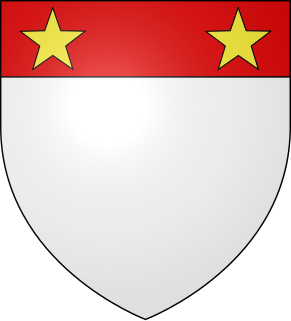Related Research Articles

Baron Dacre is a title that has been created three times in the Peerage of England, every time by writ.
The title Baron Latimer or Latymer has been created, by the definitions of modern peerage law, four times in the Peerage of England. Of these, one was restored from abeyance in 1913; one is forfeit; the other two are dormant, although their heir is well known.

The titles Baron Montacute or Baron Montagu were created several times in the Peerage of England for members of the House of Montagu. The family name was Latinised to de Monte Acuto, meaning "from the sharp mountain"; the French form is an ancient spelling of mont aigu, with identical meaning.
The title Baron Multon de/of Egremont was created once in the Peerage of England. On 6 February 1299 Thomas de Multon was summoned to Parliament. On the death of the second baron, the barony fell into abeyance in 1334.

Baron St John de/of Basing is a former title in the Peerage of England.

Ralph Dacre, 1st Baron Dacre was an English peer.

Philippa Neville, Baroness Dacre, was born at Raby Castle, Staindrop, Durham.

Thomas Dacre, 6th Baron Dacre of Gilsland was a medieval English nobleman.
Joan Dacre, 7th Baroness Dacre was a suo jure peeress of England. She was born in Gilsland, the daughter of Sir Thomas Dacre (1410–1448) and Elizabeth Bowett.
Lord Thomas de Moulton was the first Baron Multon of Gilsland.
Lady Margaret de Multon was the second to hold the title Baroness Multon of Gilsland. The title Baron Multon of Gilsland was created once in the Peerage of England. On 26 August 1307 Thomas de Multon was summoned to parliament as Baron Multon of Gilsland. As the only daughter and heiress, Margaret inherited the title and estates of her father. She married Ranulph (Ralph) de Dacre, who was summoned to parliament as Lord Dacre in 1321. The title and estates after Margaret inherited them were conveyed to the Dacre family jure uxoris.
Multon is a surname of Anglo-Saxon origin. It may have derived from the word mule and tun, meaning enclosure or farm for mules. Notable people with the surname include:
Thomas Dacre, 4th Baron Dacre of Gilsland, also Baron Greystoke was an English Member of Parliament and after his father's death a peer and major landowner in the counties of Cumberland, Yorkshire and Northumberland.
George Dacre, 5th Baron Dacre of Gilsland, also Baron Greystoke was an English peer and landowner in the county of Cumberland.
Humphrey Dacre, 1st Baron Dacre of Gilsland, was an English soldier, Cumberland landowner and peer.

William Dacre, 2nd Baron Dacre was an English peer. In the final months of his life he was also 3rd Baron Multon of Gilsland. In some sources he is called William de Dacre.

John Harington, 1st Baron Harington (1281–1347) of Aldingham in Furness, Lancashire, was an English peer, created Baron Harington by writ of summons to Parliament dated 1326.

Hugh Dacre, 4th Baron Dacre (1335–1383) was an English nobleman. He was born in 1335, the youngest son of Ralph Dacre, 1st Baron Dacre and his wife Margaret de Multon, 2nd Baroness Multon of Gilsland. His two older brothers preceded him in the barony, but both died childless. His brother William, the second baron, married but died childless in 1361. His brother Ralph, the third baron, was a clergyman who died unmarried and without issue in 1375. Hugh may have been implicated in his predecessor's death; he and Nicholas Harrington were excommunicated by the Archbishop of York, likely in connection with the murder, and they were both presented for the murder at Preston, though they escaped long-term repercussions.

Ralph Dacre, 3rd Baron Dacre was an English noble and clergyman. He was the third son of Ralph Dacre, 1st Baron Dacre and his wife Margaret de Multon, 2nd Baroness Multon of Gilsland, with two older brothers and one younger brother (Hugh). He would become the second of three of the brothers to succeed to the title of Baron Dacre.

The title Baron Cobham has been created numerous times in the Peerage of England; often multiple creations have been extant simultaneously, especially in the fourteenth century. The earliest creation was in 1313 for Henry de Cobham, 1st Baron Cobham, lord of the manors of Cobham and of Cooling, both in the county of Kent. The de Cobham family died out in the male line in 1408, with the death of the 3rd Baron Cobham, but the title continued via a female line to the Brooke family, which originated at the estate of "la Brook" near Ilchester in Somerset, and which later resided at Holditch in the parish of Thorncombe and at Weycroft in the parish of Axminster, both in Devon, both fortified manor houses. Following their inheritance, the Brooke family resided at Cobham Hall and Cooling Castle in Kent. Henry Brooke, 11th Baron Cobham, was attainted in 1603, when the peerage became abeyant instead of becoming extinct. In 1916, the attainder was removed and the abeyance terminated in favor of the fifteenth baron. The twelfth to fourteenth barons never actually held the title. This creation became abeyant again in 1951.